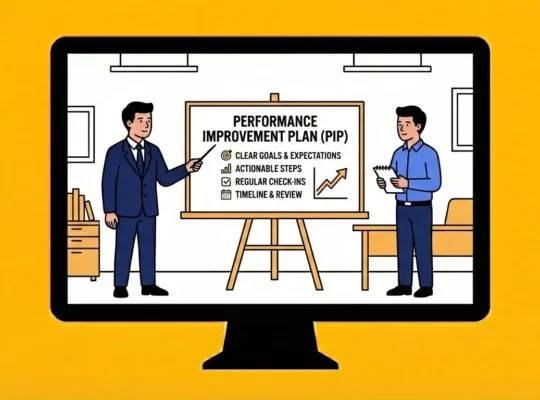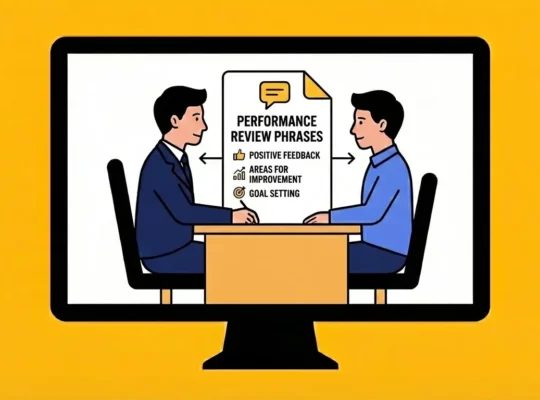Are you struggling to identify and develop your organization’s hidden talent? In today’s competitive landscape, it’s more important than ever to recognize and nurture your employees’ potential. This article will explore how using a structured talent review template benefits businesses and manage their workforce more effectively.
Table of Contents
What is a Talent Review?
A talent review is more than just an annual performance appraisal. It’s a strategic tool that helps organizations identify, attract, and retain their most valuable employees. The review considers an employee’s past achievements, growth areas, and alignment with company values, helping managers make informed decisions about career development, promotions, and succession planning.
Key Elements Evaluated in Talent Reviews
- Performance: Assess an employee’s past projects, goal completion, and contributions to the team’s success. This involves reviewing their work output, quality, and effectiveness in meeting deadlines.
- Potential: Evaluate an employee’s leadership qualities, adaptability, and long-term career trajectory. This includes assessing their ability to take on new challenges, learn quickly, and develop their skills.
- Growth Areas: Identify areas where employees can develop their skills and knowledge to reach their full potential. This may involve identifying specific training needs or providing mentorship opportunities.
- Cultural Fit: Assess how well an employee aligns with the company’s values and contributes positively to the workplace culture. This includes evaluating their attitude, teamwork skills, and ability to collaborate effectively with others.
Benefits of Using a Talent Review Template
Implementing a structured talent review template offers several advantages that can streamline HR processes and support organizational goals.
Data-Driven Decisions
One of the most significant advantages of using a talent review template is the ability to make data-driven decisions. By providing a consistent framework for evaluating employee performance, potential, and cultural fit, templates help eliminate bias and subjectivity from the review process.
Key Benefits of Data-Driven Talent Reviews
- Objective Assessments: Templates ensure that all employees are evaluated using the same criteria, reducing the risk of bias.
- Informed Decision-Making: By analyzing data-driven insights, managers can make more informed decisions regarding promotions, development, and succession planning.
- Enhanced Accuracy: Templates help to ensure that all relevant information is collected and considered, leading to more accurate assessments.
- Improved Consistency: A standardized template can help to ensure consistency in talent reviews across the organization, reducing the risk of discrepancies and inconsistencies.
Streamlining the Process
A well-designed talent review template simplifies the entire talent management process. It allows for a quicker assessment without compromising depth, making performance reviews efficient. HR teams can save time on preparation and ensure consistency across multiple evaluations by having a standardized template in place.
Key Benefits of a Standardized Template
- Efficiency: A template provides a clear structure, reducing the time and effort required for managers and employees to prepare for and conduct reviews.
- Consistency: Ensures that all employees are evaluated using the same criteria, promoting fairness and objectivity.
- Data-Driven Insights: Provides a framework for collecting and analyzing employee data, enabling managers to make informed decisions.
- Improved Communication: A clear and structured template can facilitate open and honest communication between managers and employees.
Consistency Across Reviews
By using a template, organizations guarantee that all employee performance reviews follow the same structure, ensuring fair and consistent evaluations. This uniformity is crucial for providing balanced feedback and avoiding favoritism during assessments.
Key Benefits of Consistent Reviews
- Enhanced Employee Engagement: Employees who feel that they are being evaluated fairly are more likely to be engaged and motivated.
- Improved Decision-Making: Consistent reviews provide managers with a solid foundation for making informed decisions regarding promotions, development, and succession planning.
- Enhanced Organizational Effectiveness: A fair and equitable talent review process can contribute to a more effective and productive organization.
Supporting Career Development
Talent reviews that use structured templates can highlight areas where employees need growth, such as leadership skills or technical abilities. This information allows HR teams to develop training, coaching, or succession plans that help employees reach their full potential, ultimately benefiting the company’s long-term talent management strategy.
Benefits of Using Talent Reviews for Career Development
- Employee Engagement: When employees feel that their development is being supported, they are more likely to be engaged and motivated.
- Talent Retention: By investing in employee development, organizations can improve retention and reduce turnover.
- Organizational Success: A skilled and motivated workforce is essential for long-term organizational success.
Key Components of an Effective Talent Review Template
A comprehensive talent review template should include a variety of components that capture different aspects of an employee’s contributions and future potential.
Performance Metrics
- Achievements on Past Projects: Evaluate the employee’s accomplishments on specific projects, including the quality of their work, timeliness, and impact on the team or organization.
- Contribution to Team Efforts: Assess the employee’s ability to collaborate effectively with others, share knowledge, and support team goals.
- Goal Attainment: Evaluate how well the employee has met their individual and team goals, and assess any challenges or obstacles they may have faced.
- Leadership in Collaborative Work: Assess the employee’s ability to lead or contribute to team projects, including their ability to delegate tasks, motivate others, and resolve conflicts.
Potential Assessment
Assessing an employee’s potential helps predict their future contributions to the organization. This involves evaluating:
1. Leadership Potential
- Leadership Skills: Evaluate an employee’s ability to inspire, motivate, and lead others.
- Decision-Making: Assess their ability to make sound judgments and solve problems effectively.
- Strategic Thinking: Evaluate their ability to think critically, analyze complex situations, and develop strategic plans.
2. Adaptability and Resilience
- Flexibility: Assess an employee’s ability to adapt to change and embrace new challenges.
- Resilience: Evaluate their ability to bounce back from setbacks and maintain a positive attitude.
- Problem-Solving: Assess their ability to identify and solve problems creatively and effectively.
3. Long-Term Career Trajectory
- Career Goals: Discuss the employee’s career aspirations and how they align with the organization’s goals.
- Development Needs: Identify any skills or knowledge gaps that need to be addressed to support their career growth.
- Succession Planning: Assess an employee’s potential to fill key leadership roles in the future.
Competency Assessment
Competencies refer to the essential skills and abilities that employees need to excel in their roles. These include both:
1. Technical Skills
- Specific Expertise: Proficiency in using software, tools, or techniques required for the job.
- Industry Knowledge: Understanding of industry-specific processes, regulations, and trends.
- Technical Proficiency: Demonstrated ability to perform tasks efficiently and accurately.
2. Soft Skills
- Communication: Effective verbal and written communication skills.
- Teamwork: Ability to collaborate effectively with others and contribute to team success.
- Problem-Solving: The ability to identify and solve problems creatively and efficiently.
- Adaptability: Flexibility and willingness to adapt to change.
- Cultural Fit: Alignment with the organization’s values and culture.
9-Box Grid Format
The 9-box grid is a popular method for evaluating employees based on their performance and potential. It visually categorizes employees into nine different sections, making it easier for HR teams to identify those who are high performers with high potential, as well as those who may need additional support or training.
How the 9-Box Grid Works
- Performance Axis: The horizontal axis represents an employee’s performance, ranging from low to high.
- Potential Axis: The vertical axis represents an employee’s potential for growth and development, also ranging from low to high.
- Nine Sections: The grid is divided into nine sections, each representing a different combination of performance and potential.
Development Plan Section
A well-rounded talent review template should include a section dedicated to the employee’s future development. This section outlines opportunities for:
- Training and Certifications: Identify any necessary training or certifications to enhance the employee’s skills and knowledge.
- Promotions and Lateral Moves: Discuss potential career paths and opportunities for advancement within the organization.
- Coaching and Mentorship: Identify suitable mentors or coaches who can provide guidance and support.
- Self-Assessment: Encourage employees to participate in their own reviews by completing a self-assessment.
Self-Assessment Integration
One of the most effective ways to foster employee engagement and development is to encourage them to participate in their own talent reviews. By including a self-assessment section in your template, you can:
- Promote Self-Awareness: Encourage employees to reflect on their strengths, weaknesses, and areas for growth.
- Increase Engagement: Empower employees to take ownership of their career development.
- Align Goals: Help employees align their personal and professional goals with the organization’s objectives.
- Foster Accountability: Create a sense of accountability and responsibility for their own growth.
The 4 Most Popular Talent Review Templates
Several templates are widely used in organizations for evaluating employees’ performance and potential.
1. 9-Box Talent Review Template
The 9-box grid talent review template organizes employees based on their performance and potential, offering a clear visual representation. This helps in identifying high-potential employees and understanding which areas require improvement.
| 9-Box Grid | Potential High | Potential Medium | Potential Low |
| Performance High | Future Leaders | Solid Performers | Rising Stars |
| Performance Medium | Growth Opportunities | Steady Contributors | Underperformers |
| Performance Low | At Risk | Need Improvement | Exit Candidates |
2. Team Performance Assessment Template
This template focuses on evaluating the performance of an entire team rather than individual employees. It helps assess:
Team Achievements
- Key Projects: Summarize the team’s major accomplishments and contributions during the assessment period.
- Goals Achieved: Outline the goals that the team successfully met or exceeded.
- Challenges Overcome: Discuss any significant challenges or obstacles that the team faced and how they were addressed.
Team Dynamics
- Collaboration: Evaluate the effectiveness of teamwork and collaboration within the team.
- Communication: Assess the quality and clarity of communication among team members.
- Conflict Resolution: Evaluate the team’s ability to resolve conflicts and disagreements constructively.
Individual Contributions
- Strengths and Weaknesses: Identify the individual strengths and weaknesses of each team member.
- Areas for Improvement: Outline specific areas where team members can develop their skills or knowledge.
- Recognition: Acknowledge and reward outstanding contributions from individual team members.
3. 360-Degree Feedback Template
A 360-degree feedback template gathers input from managers, employee reviews, and even customer feedback to create a well-rounded assessment of an employee’s performance and behavior. This method is particularly effective in project management environments where multiple perspectives are valuable.
4. Self-Assessment Template
A self-assessment template empowers employees to evaluate their own performance, allowing them to highlight their achievements and identify growth opportunities. This feedback can be used in conjunction with other performance review methods to provide a comprehensive view of an employee’s progress.
Best Practices for Implementing Talent Reviews
When implementing talent reviews, there are several best practices to ensure that the process is effective and contributes to organizational growth.
Align Templates with Company Goals
Ensure that the talent review templates you use are aligned with your company’s specific goals and culture. This alignment ensures that employees are being evaluated based on criteria that matter most to your organization.
Use Clear and Unbiased Criteria
To avoid favoritism and ensure fairness, it’s essential to use objective criteria when filling out talent review templates. Standardizing the review process prevents bias from influencing decisions about employee performance and potential.
Regularly Update the Template
As your business grows, your talent review template should evolve with it. Regularly update the template to reflect changing business needs, new roles, or evolving competencies.
Provide Actionable Feedback
During talent review meetings, ensure that the feedback provided is specific, actionable, and focused on helping employees grow. Whether it’s a promotion, succession planning, or further training, employees should leave the review with clear actionable goals.
Leveraging Talent Reviews for Organizational Growth
Talent reviews are more than just performance evaluations—they are an essential tool for driving business growth and building a stronger workforce.
Identify High-Potential Employees
Talent reviews help organizations identify high-potential employees who are ready to take on leadership roles or other critical positions. By recognizing and developing these individuals, businesses can ensure they have a strong leadership pipeline.
Improve Employee Engagement and Satisfaction
A structured review process that includes clear feedback and growth opportunities can boost employee engagement and satisfaction. When employees know their contributions are valued and that there is a clear path for their development, they are more likely to stay motivated.
Create Data-Backed Career Development Pathways
Using talent review templates allows HR teams to create data-backed career development pathways. By analyzing employee performance and potential over time, companies can design personalized development plans that align with business objectives.
Incorporating a structured talent review template into your organization’s HR process is crucial for maintaining fairness, identifying future leaders, and driving company success. By focusing on data-driven evaluations, career development, and growth opportunities, you can ensure that your talent management efforts are aligned with business objectives.





